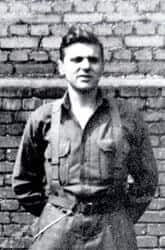War is About People

Although the 70th anniversary of the great Second World War has come and gone, we’d like to spotlight one more WWII veteran who calls Advent Christian Village home before we close this book. Our final interview is with a soldier who never lost sight of what this war was all about: people.
Ed Siergiej entered the US Army at 18. He was drafted while attending Danbury State Teachers College after only a year and a half of schooling and sent to basic training in Georgia. Following basic, Ed was sent to the Army Specialized Training Program at Norwich University in Northfield, Vermont. He was to be trained in engineering, but after only a few months, the ASTP was cancelled and Ed and his fellow students were sent to Tennessee and assigned to the 17th Airborne Division. They were to be shipped overseas as part of a glider infantry.
Ed has many harrowing tales concerning his time in Europe during World War II. And his first brush with death came even before being sent into battle. A routine glider training flight — a flight he was pulled from at the last minute because he was skilled in typing — crashed and everyone on board was killed.
Ed and his company were flown to southern France to enter the fray. Despite their training in gliding in behind enemy lines, they were trucked to the area of Bastogne during the Battle of the Bulge: six hours of standing shoulder to shoulder in the back of a truck.
Ed and his family have returned many times to the areas he visited during World War II. The locals of that area say that it was much colder, and much more snow fell during that time than usual. Ed remembers just how miserable it was. He and another man dug a foxhole just big enough for the two of them to stand or crouch in to try to live through the battle. They had covered the foxhole with a coat and by morning, the snow had caved in the foxhole. Frostbite was a fear, but Ed was spared.
Ed and his company were in that area for the whole of the Battle of the Bulge. Then, they were summoned to the Rhine River. Ed and the 17th were part of Operation Varsity, landing in Wesel, Germany, and then marching to Berlin. The Germans were faltering and the war was coming to an end.
After taking Berlin, the 17th remained on occupation duty. Schools were set up, and Ed was part of the liberation of a concentration camp.
After the war ended, the 17th was divided into three groups. Those who had been serving the longest were shipped home to be discharged. Those who had been serving the least were also shipped home with the intent of being reassigned to the south Pacific. Those in between, including Ed, were transferred to the 82nd Airborne. According to Ed, they spent the next two weeks practicing marching.
The 82nd returned to the States on the Queen Mary and led the Victory Parade on Jan. 12, 1946, in New York City. Ed was able to invite his parents down from Connecticut and they watched the parade from a stage alongside the mayor of NYC.
After the parade, Ed was discharged. It was expected that Ed would go into medicine, but he was having trouble making up his mind, so he returned to finish his degree from Danbury State Teachers College. By the time he had finished, he decided to be an educator instead of a physician. He went on to get his master’s degree from Columbia University, and did everything but write his thesis toward a doctorate.
It was while he was back at Danbury that Ed started dating Mary Taylor. Ed and Mary had gone to high school together, but didn’t really know each other. It was after a notice appeared in their hometown paper that Mary had been invited to attend the Metropolitan Opera’s Chorus School that Ed took an interested in Mary. The two began dating in 1948, were married in 1954, and eventually had two sons.
Ed worked for New York’s Board of Education in both Great Neck and Rockville Centre. His area of focus was the brand new and growing area of audio and visual aids. He primarily taught teachers how to use these aids to enhance their classes.
Ed retired in 1980, but only a few years later, he was just as busy helping organize the 17th Airborne Division Association, an organization formers members of the 17th Airborne could join. By 1985, 5,000 of the 17th’s 20,000 men were members. The Association got together regularly all across the US and overseas. Ed was the secretary for this group until 2008.
Ed and Mary moved to Advent Christian Village at the urging of Mary’s brother, Frank, for whom Taylor Commons, ACV’s newest neighborhood, is named. They’ve lived here for many years and have been very involved.
To Ed and all the other veterans living at Advent Christian Village, we say thank you. We are proud of your service and pleased to have you living among us.



